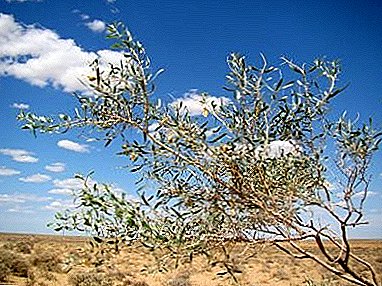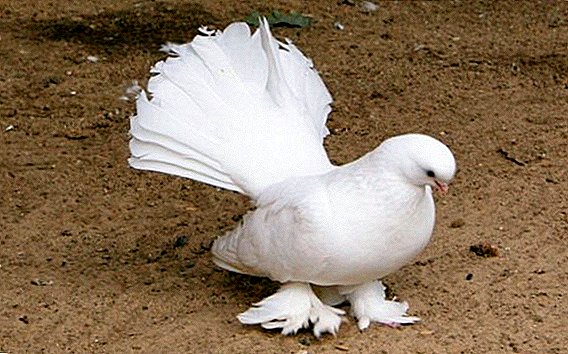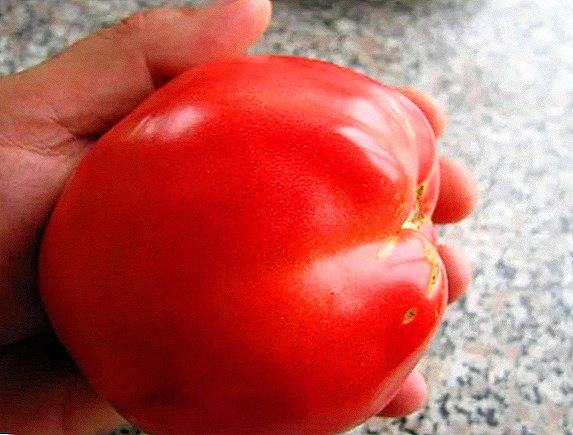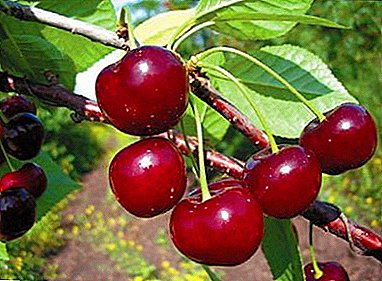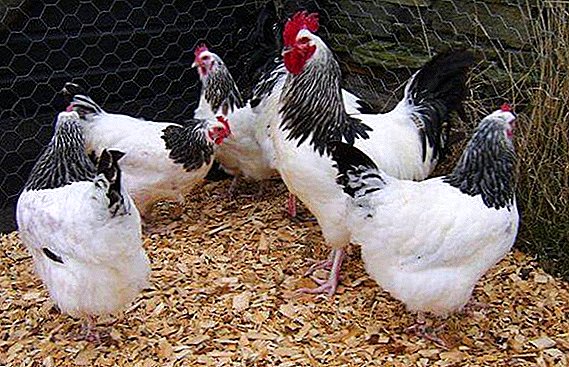 Crosses of chickens, in fact, are hybrids. When a rooster of one breed is crossed with chickens of other breeds, they get crosses. This is a fairly complex process, since it is necessary to select the best representative of the breed and the most powerful and persistent female (there may be a few, even a few species). Zootechnicians have special formulas by which crossing takes place, and in some cases even blood transfusions are permissible. Let's see what cross crosses chickens are considered the best for the egg direction.
Crosses of chickens, in fact, are hybrids. When a rooster of one breed is crossed with chickens of other breeds, they get crosses. This is a fairly complex process, since it is necessary to select the best representative of the breed and the most powerful and persistent female (there may be a few, even a few species). Zootechnicians have special formulas by which crossing takes place, and in some cases even blood transfusions are permissible. Let's see what cross crosses chickens are considered the best for the egg direction.
Distinctive features of egg crosses
It has been scientifically proven that cross females are more hardy, better adaptable and have higher productivity. However, such efficiency is noted only in the first generation. That is, to deduce the second generation and further simply does not make sense.  Therefore, the cross is usually held at the industrial scale farms, private farms are not profitable, because the chickens have to buy each year.
Therefore, the cross is usually held at the industrial scale farms, private farms are not profitable, because the chickens have to buy each year.
Criteria for selection of egg hens
Breeding chickens has two directions: meat and egg. Crosses of the egg direction are marked by high egg production. If we compare with the rocks, the hybrid laying hen can produce up to 300 eggs per year, while the representative of pure breed - only to 200, the difference is quite noticeable.
Did you know? The famous expression "chicken brains" appealing to the folly of birds is not quite right. So, remember the birds and distinguish about hundreds of people's faces and relatives, find out the owner, punctual (oriented in time).
Criteria for choosing hens:
- Appearance. Visually, the bird must be clean. The plumage cannot have any bald patches or growths, since this means that the individual is sick. Be sure to pay attention to the feathers around the anus. If there are residues of feces, it means that the layer is susceptible to intestinal infection. Also, the bird should not be too thin or fat, its performance depends on it.
- Leather. The skin color of a healthy individual is pale pink. If you notice some yellowing of the skin, it may mean that the bird has serious liver problems. This can affect her egg production and lifespan.
- Keel. If it is not even, then the individual is sick with rickets.
- Head. A red or pink comb of a regular shape, warm to the touch is a sign of a healthy bird. Eyes must be bright, beak without growths, and nostrils are dry. This suggests that the individual is healthy.
- Belly. If the bird is soft but elastic, such a layer is considered suitable.
- Legs. Only straight. They should also be widely spaced, which indicates a high reproduction ability of the crosses.
- Fatness. As noted above, the bird should be a normal build. A lot of fat or painful thinness does not lead to anything good.
- Lone bones. The distance between them should not be more than 3 fingers. And the distance from the rear end of the keel to the pubic bones is no wider than 4 fingers.
- Activity. Chicken can not be lethargic, because it speaks of poor health, which is directly related to egg production.
- Spurs. They should not be. After all, this suggests that the crossing was closely related. Such a bird will not produce many eggs.

The right choice of laying hen crosses is a guarantee of high performance.
Best representatives
Depending on the color of the shell, the eggs of the crosses can be divided into white and brown. Next, consider the representatives of these categories.
The breeds of hens of the egg direction also include such breeds as super nickname, brown nickname, rhodonite, Moravian black.
White crosses
White eggs carry chickens, in which the Leggorn breed was involved in cross-breeding. This is the most common breed in the world. The color of the plumage in representatives of this breed can be brown, black, blue, golden, but most often it is white.
Leghorn are distinguished by rapid acclimatization, good endurance and precocity.
Important! Chickens - creatures are not as talkative as geese, but you will not be able to sit in silence. Birds comment on what is happening, pick up clucking each other. However, if your hen house is constantly quiet, it may be a signal to pay attention to the health of pets.
Belarus 9-U
A very popular cross, derived for the first time in Belarus from the White Leghorn and California Gray breeds. White large birds with medium egg production. 
Specifications:
- average weight is about 2 kg;
- feed intake - up to 115 g per day;
- productivity - up to 260 eggs per year.
One of the main competitive advantages is a high adaptability to the most different conditions of the birds.
Borki-117
It can be considered an improved type of cross Belarus 9-U. It looks very similar to the previous type, but the performance is 25% higher. 
Specifications:
- average weight is about 2 kg;
- feed intake - up to 115 g per day;
- productivity - up to 345 eggs per year.
Bred in Ukraine, Kharkiv UAAN back in 1973, but until 1998 the cross was improved, improving the quality characteristics.
Dekalb white
Pure egg type chickens. Bred by the famous Dutch company Hendrix Genetics in cooperation with the Institute of Animal Husbandry ISA.
Learn more about the features of breeding decalb at home.
These birds are of very modest weight, but with a very large crest, often falling to one side. 
Specifications:
- average weight - 1.6 kg;
- feed intake - up to 110 g per day;
- productivity - up to 415 eggs per year.
A very calm character is inherent in the cross, which is why birds live well at home. The weak spot of Dutch birds is sensitivity to change and stress. Change the host chicken coop, the attack on the Kindred, and other stressful situations can make chickens fearful, anxious and affect productivity.
Isa White
The authorship of this cross, as the previous one, belongs to the Dutch concern Hendrix Genetics. In matters of animal husbandry, this company is a kind of quality mark. 
Specifications:
- average weight - 1.8 kg;
- feed intake - not higher than 110 g per day;
- productivity - up to 420 eggs per year.
The calm and friendly birds of Isa White are great not only for factory-made, but also for home breeders. Easy to care, unpretentious in the conditions and food, have excellent immunity.
Loman White
Small, light and not at all voracious birds of this cross belong unequivocally to the direction of the egg. Peaceful temperament is connected with a very active lifestyle, these birds are constantly in motion. 
Specifications:
- average weight - up to 1.7 kg;
- feed intake - no higher than 100 g per day;
- productivity - up to 350 eggs per year.
It is characterized not only by a high number of eggs per year, but also by a large average egg weight (it can reach 64 g / piece). It is also interesting that the white chickens of Lohman rush all year round, regardless of climate.
Start H-23
Russian cross bred on the basis of the Leggorn breed. Refers to the direction of the egg, but can easily be used for meat production. 
Specifications:
- average weight - up to 2 kg;
- feed intake - not higher than 110 g per day;
- productivity - 280-300 eggs per year.
Large, but unpretentious in feeding birds. They differ not only in the high number of eggs laid per year, but also in the size of these same eggs (on average, 60-62 g / piece).
Hisex White
One of the most popular crosses in the world. They have Dutch roots, they are derived from the Leggorn and New Hampshire subsidiary of Hendrix Genetics. 
Specifications:
- average weight - up to 1.8 kg;
- feed intake - no higher than 100 g per day;
- productivity - 300 eggs a year.
Did you know? Ukraine (Ukrainian SSR) was one of the first countries to introduce these highly productive crosses. So, the breed was bred in 1970, and after four years the birds received one of the country's collective farms. Amazing results almost immediately spread the birds of this species almost throughout the USSR. Only by 1985, the birds spread to other countries and continents, and in 1998 appeared on all continents except Antarctica.
Differs in excellent immunity (including to fungal diseases and helminths). It is considered a very economically feasible species due to low grain consumption, but at the same time high egg productivity.
High Line W-36
Egg cross, bred in the USA by Hi-Line International, hence the name of the species. Type W-36 is the most productive of the entire line. 
Specifications:
- average weight - up to 2 kg;
- feed intake - 110 g per day;
- productivity - up to 290 eggs per year.
Calm, survivable birds, giving a lot of eggs. Not particularly prone to stress, conflict and aggression within their team.
Shaver white
This cross was developed in Germany and is characterized by high productivity with low feed consumption. 
Specifications:
- average weight - up to 2 kg;
- feed intake - up to 110 g per day;
- productivity - up to 350 eggs per year.
They are active and inquisitive, constantly in motion and searching for goodies in the area allocated to them. Bird health is very good, but they are sensitive to cold and drafts.
Learn about the features of growing a heifer chickens: white, brown, black.
Brown Crosses
Just like whites, they are distinguished by rather high productivity, because Leghorny also participated in their creation. Although now the basis of these crosses most often breeds Rhode Island and New Hampshire. The main differences from whites are the greater weight of the birds, the greater mass of eggs, resistance to stress and better endurance.
Bovans Gold Line
One of the most popular crosses on the territory of Ukraine, where he was bred. Large brown birds produce large (62-64 g / pc.) Brown eggs. 
Specifications:
- individual weight - from 2 kg;
- feed intake - 114 g per day;
- productivity - about 332 eggs per year.
In terms of weight / feed ratio, it is considered a very productive species. It can be used not only for egg, but also for meat.
Borki-color
The Ukrainian species was bred in the Borka Experimental Farm at the Institute of Poultry UAAS in Kharkov. Two-color cross, in which females are brown, and males are white. 
Specifications:
- individual weight - 2.1 kg;
- feed intake - up to 115 g per day;
- productivity - about 260 eggs per year.
They give medium brown eggs weighing on average about 60 g / pc. It differs from similar species simplicity of obtaining hybrid survivability and accuracy of sex determination (the first day precision color differentiation reaches 97-98%).
Dominant 102
Massive brown birds, obtained by crossing breeds of Rhodeland. As Borki is a clear separation by gender in plumage color - brown hens and roosters white. 
Specifications:
- individual weight - up to 2.5 kg;
- feed intake - 125 g per day;
- productivity - up to 315 eggs per year.
Heavy and productive birds can be grown for meat and eggs. They love heat, so that from hypothermia can get sick, demanding on food. Kormozhka unsuitable feed fraught shortening oviposition, general decrease in the number of eggs demolished.
In contrast to most crosses, dominant chicks have maternal instincts.
Isa Brown
Netherlands cross, like Isa White. Females of this species are brown, and males are lighter - yellowish-beige. 
Specifications:
- individual weight - 1.9 kg;
- feed intake - 110 g per day;
- productivity - up to 320 eggs per year.
Large chickens give the same large brown eggs (63-64 g / pc.). Easy to care and quite picky.
Lohman Brown
Brown cross German company Lohmann Tierzucht. The birds of Lohman (White and Brown) are very popular in Western Europe and South America. It should be noted that this species has existed since the 50s and became the hallmark of the company.  Lohmann breeding breeders decided topical issue for the post-war years - the preservation of maximum productivity with changing environmental conditions (climate, diet).
Lohmann breeding breeders decided topical issue for the post-war years - the preservation of maximum productivity with changing environmental conditions (climate, diet).
Specifications:
- individual weight - 1.74 kg;
- feed intake - 102 g per day;
- productivity - 280-300 eggs per year.
An alternative name for the species is “red chicken” because of the reddish shade of brown feathers. However, color variations with light and dark flashes are permissible.
Progress
Russian cross, bred in Penza at the Pachelma goslemptitszavod. Also has a difference in color depending on the gender. 
Specifications:
- individual weight - up to 3 kg;
- feed intake - 155 g per day;
- productivity - 260 eggs per year.
Hisex Brown
Like the white version of the cross, is one of the most popular species in the world. 
Specifications:
- individual weight - up to 2 kg;
- feed intake - up to 110 g per day;
- productivity - 365 eggs per year.
Well endured a cold, can rush all the year round. It is more productive than the white subspecies.
High Line Brown
American cross egg directions. The easy quiet breed possessing excellent health and big egg production. 
Specifications:
- individual weight - 1.65-1.74 kg;
- feed intake - 110 g per day;
- productivity - up to 330 eggs per year.
The peaceful nature and strong immunity make this species attractive for mass rearing of birds, however the white species is considered more economically advantageous.
High Line Silver Brown
Another subspecies of the High Line cross, the birds have white plumage, but they carry brown eggs. 
Specifications:
- individual weight - up to 1.75 kg;
- feed intake - 110 g per day;
- productivity - 330-350 eggs per year.
Mass, productivity and other characteristics are not very different from the brown subspecies.
Tetra SL
Unusual Hungarian Cross of Babolna TETRA with dark reddish-brown eggs and dark reddish plumage of birds. The weight of eggs is quite substantial (63-65 g / pc.). 
Specifications:
- individual weight - up to 2 kg;
- feed intake - up to 125 g per day;
- productivity - up to 305 eggs per year.
Distinguished by the rapid growth and maturation of the young, for which he fell in love with private farms. It is considered not only egg, but also a meat type because of high-quality dietary meat.
Crosses of hens of the egg direction: tips on the maintenance and care
For high performance cross-country it is necessary to follow the rules of care and maintenance of birds. After all, even completely healthy individuals can get sick with inadequate conditions of detention.
You will also be interested to learn about the features of the content in the home of the chickens cross as Super Harco, oats, avikolor, farming of color and space.
Primary requirements:
- the bird’s permanent residence should be clean and spacious enough;
- individuals must have constant unhindered access to fresh water;
- it is not necessary to exceed and underestimate the recommended feed intake rates for each species of birds, as this may cause diseases;
- regular inspection of the livestock to identify parasites and signs of mass disease will help prevent the loss of layers.
 Following these rules, you are guaranteed to protect the livestock of birds from diseases, improve the quality of eggs.
Following these rules, you are guaranteed to protect the livestock of birds from diseases, improve the quality of eggs.Important! Consider that one of the weak points of most crosses is the maternal instinct, or rather, its absence. If you need birds for breeding, you should immediately take into account the need for an incubator or the creation of incubator conditions at home. If the bird plant for meat or eggs, then this genetic feature, rather an advantage than a disadvantage.
Depending on the needs of your farm, certain types of chickens will do. Whatever crosses you choose, do not forget about the basic requirements for the care of birds: cleanliness, prevention and moderate nutrition.


